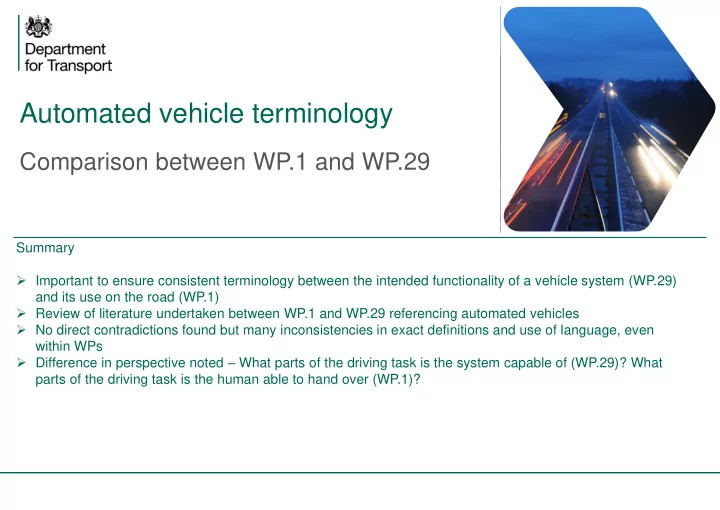

Automated vehicle terminology Comparison between WP.1 and WP.29 Summary ➢ Important to ensure consistent terminology between the intended functionality of a vehicle system (WP.29) and its use on the road (WP.1) ➢ Review of literature undertaken between WP.1 and WP.29 referencing automated vehicles ➢ No direct contradictions found but many inconsistencies in exact definitions and use of language, even within WPs ➢ Difference in perspective noted – What parts of the driving task is the system capable of (WP.29)? What parts of the driving task is the human able to hand over (WP.1)? 1
Documents referencing automation Documents in bold have already been adopted Documents in light are informal / non-adopted texts Documents in red have since been adopted by GRVA (subject to modifications) WP.1 Documents WP.29 Documents Global Forum for Road Traffic Safety (WP.1) resolution on the Regulation 152.00 (Advanced emergency braking) deployment of highly and fully automated vehicles in road Regulation 79.03 (Steering equipment with lane change traffic manoeuvre) Consolidated Resolution on the Construction of Vehicles (R.E.3) Autonomous Vehicles: Challenges and Opportunities A regulatory Revised Framework document on automated/autonomous framework supporting innovation vehicles Reference document with definitions of Automated Driving Global Forum for Road Traffic Safety (WP.1) resolution on the under WP.29 and the General Principles for developing a UN activities other than those related to driving, that a driver of a Regulation on automated vehicles vehicle equipped with an automated driving system, could undertake when the automated driving system is engaged (DRAFT) Draft text for regulation on ALKS Automated Driving: Proposal for identifying how the 1968 Vienna Draft text for regulation on cyber security Convention on Road Traffic may need to be amended to clarify the use of automated vehicles (Informal proposal) Draft text for regulation on DSSAD Automated driving: Situations when a driver operates a vehicle from the outside of the vehicle Draft text for regulation of over the air updates Working document GRVA/2019/21e 2
Comparison tables Excel sheet showing a reduced set of terminology – with definitions and highlighting where there is overlap 3
Harmonies and conflicts Few examples of direct overlap in terminology, significant examples include: “Highly automated vehicle” – refers to a vehicle equipped with an automated driving system. This automated driving system operates within a specific operational design domain for some or all of the journey, without the need for human intervention as a fall-back to ensure road safety - Global Forum for Road Traffic Safety (WP.1) resolution on the deployment of highly and fully automated vehicles in road traffic “Highly automated (vehicle)” – the automation executes control of essential parts of the driving task, such as integrated lateral and longitudinal control and the driver mainly monitors the automation, takes over when necessary, hand-on or hand-off driving can be both classified as highly automated - Consolidated Resolution on the Construction of Vehicles (R.E.3, WP.29) 4
Harmonies and conflicts “Driver assistance system” - means the combination of hardware and software that assists, but does not replace, the driver in exercising dynamic control. - Automated Driving: Proposal for identifying how the 1968 Vienna Convention on Road Traffic may need to be amended to clarify the use of automated vehicles (Informal proposal – January 2019) “ADAS (Advanced Driver Assistance Systems)” - have been developed to support drivers and enhance road safety - Consolidated Resolution on the Construction of Vehicles (R.E.3, WP.29) WP.29 specifically defines a number of different levels of driver assistance systems (e.g. ADAS L1-3 in R.E.3, and ACSF A-E in Regulation 79.03) 5
Harmonies and conflicts Operational design domain – “ refers to the environmental, geographic, time-of-day, traffic, infrastructure, weather and other conditions under which an automated driving system is specifically designed to function. ” - Global Forum for Road Traffic Safety (WP.1) resolution on the deployment of highly and fully automated vehicles in road traffic Operational Design Domain (ODD/OD) – “ For the assessment of the vehicle safety, the vehicle manufacturers should document the OD available on their vehicles and the functionality of the vehicle within the prescribed OD. The OD should describe the specific conditions under which the automated vehicle is intended to drive in the automated mode. The OD should include the following information at a minimum: roadway types; geographic area; speed range; environmental conditions (weather as well as day/night time); and other domain constraints. ” - Revised Framework document on automated/autonomous vehicles (WP.29) In these descriptions the intended meaning is consistent between WP.1 and WP.29 but the definitions differ 6
Other inconsistencies Although there is no direct contradiction, some use of terminology is inconsistent e.g. “Dynamic control” refers to carrying out all the real -time operational and tactical functions required to move the vehicle. This includes controlling the vehicle’s lateral and longitudinal motion, monitoring the road environment, responding to events in the road traffic environment, and planning and signalling for manoeuvres - Global Forum for Road Traffic Safety (WP.1) resolution on the deployment of highly and fully automated vehicles in road traffic “Dynamic Driving task” means the control of all longitudinal and lateral movements of the vehicle – Regulatory text for ALKS Should “dynamic control” be defined in terms of the “dynamic driving task” or should they be the same? 7
SAE Levels 0-5 SAE levels mentioned in various documents between WP.1 and WP.29 but definitions are not consistent and not those of SAE J3016 Sometimes “Levels” mentioned with no reference to SAE E.g. Cyber Security text intentionally does not reference SAE levels, but levels defined in the reference document with definitions of Automated Driving under WP.29 “… automated driving functionalities from level 3 onwards, as defined in the reference document with definitions of Automated Driving under WP.29 and the General Principles for developing a UN Regulation on automated vehicles (ECE/TRANS/WP.29/1140).” 8
Recommend
More recommend